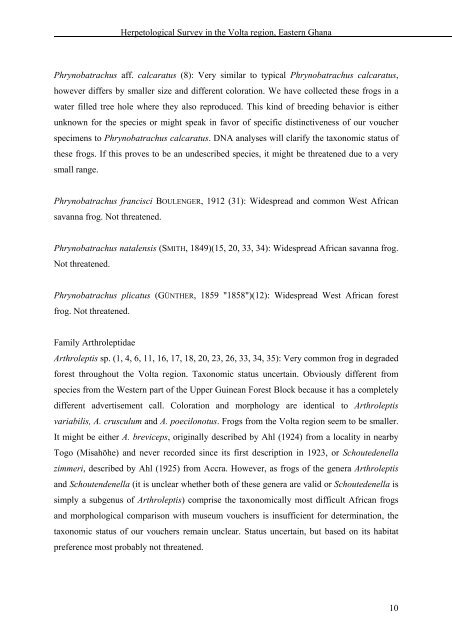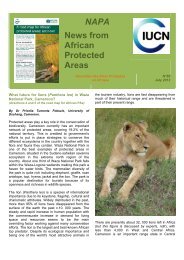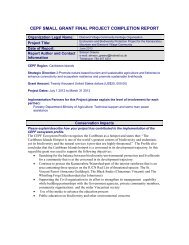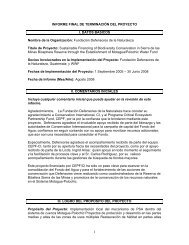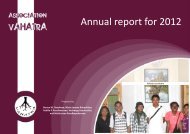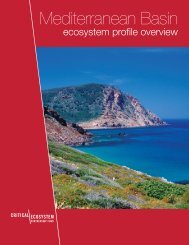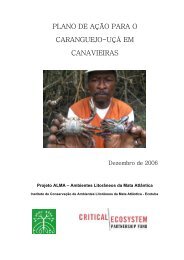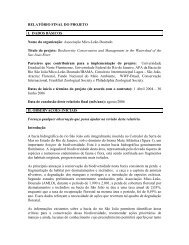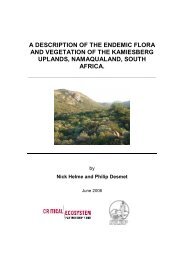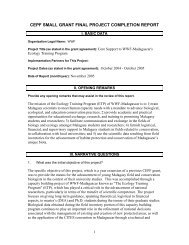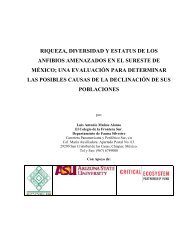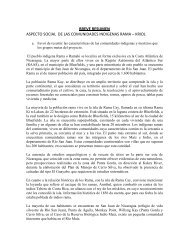Herpetological survey in the Volta region, Eastern Ghana - Critical ...
Herpetological survey in the Volta region, Eastern Ghana - Critical ...
Herpetological survey in the Volta region, Eastern Ghana - Critical ...
Create successful ePaper yourself
Turn your PDF publications into a flip-book with our unique Google optimized e-Paper software.
<strong>Herpetological</strong> Survey <strong>in</strong> <strong>the</strong> <strong>Volta</strong> <strong>region</strong>, <strong>Eastern</strong> <strong>Ghana</strong><br />
Phrynobatrachus aff. calcaratus (8): Very similar to typical Phrynobatrachus calcaratus,<br />
however differs by smaller size and different coloration. We have collected <strong>the</strong>se frogs <strong>in</strong> a<br />
water filled tree hole where <strong>the</strong>y also reproduced. This k<strong>in</strong>d of breed<strong>in</strong>g behavior is ei<strong>the</strong>r<br />
unknown for <strong>the</strong> species or might speak <strong>in</strong> favor of specific dist<strong>in</strong>ctiveness of our voucher<br />
specimens to Phrynobatrachus calcaratus. DNA analyses will clarify <strong>the</strong> taxonomic status of<br />
<strong>the</strong>se frogs. If this proves to be an undescribed species, it might be threatened due to a very<br />
small range.<br />
Phrynobatrachus francisci BOULENGER, 1912 (31): Widespread and common West African<br />
savanna frog. Not threatened.<br />
Phrynobatrachus natalensis (SMITH, 1849)(15, 20, 33, 34): Widespread African savanna frog.<br />
Not threatened.<br />
Phrynobatrachus plicatus (GÜNTHER, 1859 "1858")(12): Widespread West African forest<br />
frog. Not threatened.<br />
Family Arthroleptidae<br />
Arthroleptis sp. (1, 4, 6, 11, 16, 17, 18, 20, 23, 26, 33, 34, 35): Very common frog <strong>in</strong> degraded<br />
forest throughout <strong>the</strong> <strong>Volta</strong> <strong>region</strong>. Taxonomic status uncerta<strong>in</strong>. Obviously different from<br />
species from <strong>the</strong> Western part of <strong>the</strong> Upper Gu<strong>in</strong>ean Forest Block because it has a completely<br />
different advertisement call. Coloration and morphology are identical to Arthroleptis<br />
variabilis, A. crusculum and A. poecilonotus. Frogs from <strong>the</strong> <strong>Volta</strong> <strong>region</strong> seem to be smaller.<br />
It might be ei<strong>the</strong>r A. breviceps, orig<strong>in</strong>ally described by Ahl (1924) from a locality <strong>in</strong> nearby<br />
Togo (Misahöhe) and never recorded s<strong>in</strong>ce its first description <strong>in</strong> 1923, or Schoutedenella<br />
zimmeri, described by Ahl (1925) from Accra. However, as frogs of <strong>the</strong> genera Arthroleptis<br />
and Schoutendenella (it is unclear whe<strong>the</strong>r both of <strong>the</strong>se genera are valid or Schoutedenella is<br />
simply a subgenus of Arthroleptis) comprise <strong>the</strong> taxonomically most difficult African frogs<br />
and morphological comparison with museum vouchers is <strong>in</strong>sufficient for determ<strong>in</strong>ation, <strong>the</strong><br />
taxonomic status of our vouchers rema<strong>in</strong> unclear. Status uncerta<strong>in</strong>, but based on its habitat<br />
preference most probably not threatened.<br />
10


